Call identification of Europe’s first Paddyfield Pipit
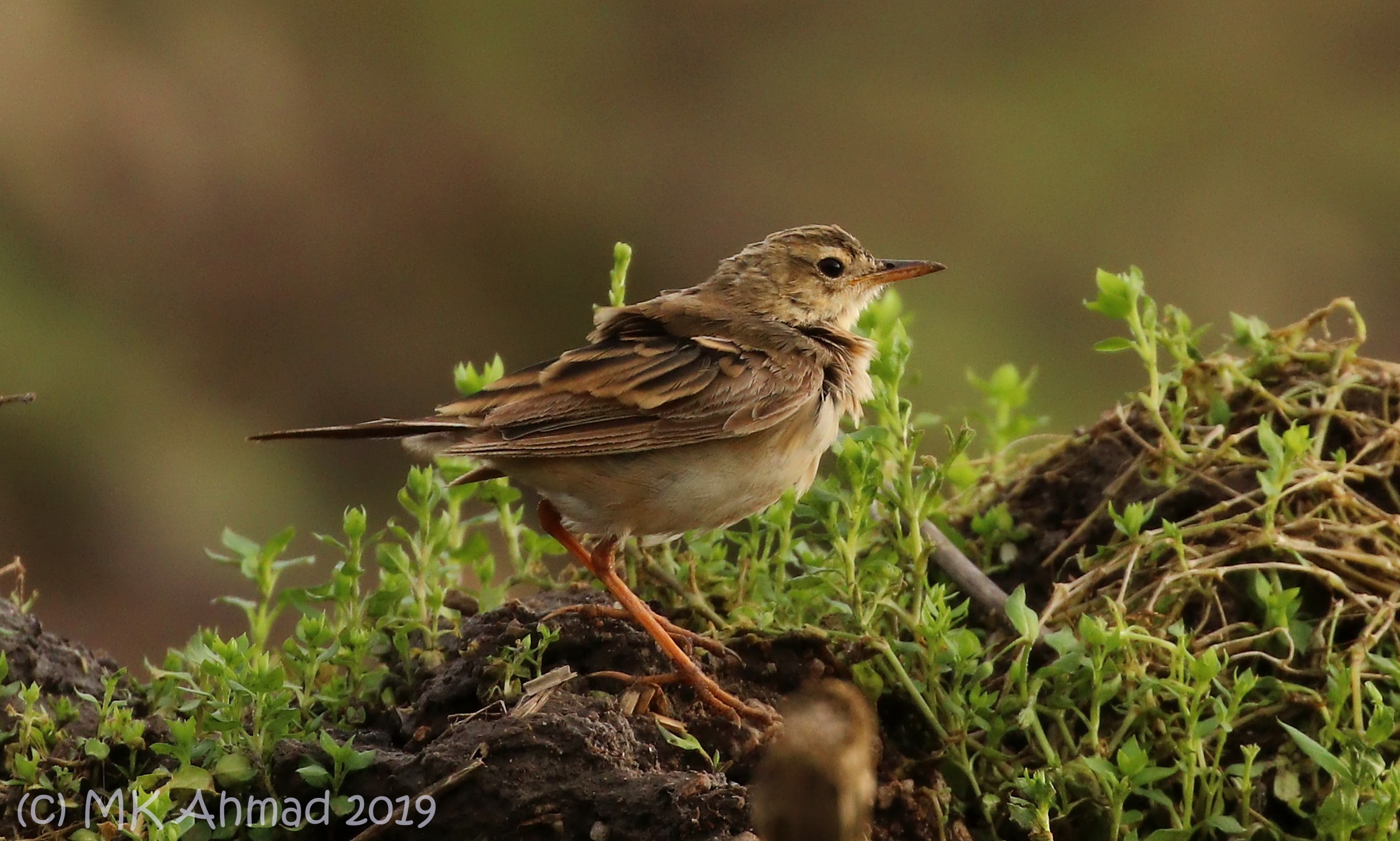
Mystery pipit Anthus Sennen, Cornwall, England, 3 November 2019 (Mashuq Ahmad).
The first I heard about the mystery pipit at Sennen, Cornwall, England, was when James Lidster alerted me to a recording by Toby Phelps, after which I received a slightly clearer recording from Nick Moran. According to James the bird was being written off as a Richard’s Pipit Anthus richardi by some observers and commentators but James thought it sounded much more like Blyth’s Pipit A. godlewskii. I listened to the recording and I could agree instantly that it was not Richard’s Pipit. To me, however, the single short chip call sounded sharper than usual for Blyth’s.

Mystery pipit Anthus, Sennen, Cornwall, England, 24 October 2019 (Nick Moran). Note that there is a longer recording further down.
Flight calls of pipits have always made my blood flow faster. When I lived in the Netherlands, Meadow Pipits A pratensis were the quintessential sound of autumn migration. Other pipits commonly passing at that season included Tree Pipit A trivialis, Eurasian Rock Pipit A petrous and Water Pipit A spinoletta. I loved the challenge of picking out the rarer ones, and Richard’s Pipit was one that I would hear migrating several times each autumn. Blyth’s Pipit was always a species I dreamed of. It was essential for me to learn its calls if I was ever to find one. I learned them from recordings, through field experience in Asia and by twitching vagrants in the Netherlands. By the late 1990s I had a clear ‘search image’ of Blyth’s calls in my mind, both the sounds and the shapes that appear in sonagrams. Eventually after moving to Portugal this paid off in the form of two vagrants, one in 2010 and another in 2016. Here is a recording of the first one, an initial longer call followed by an intermediate call and two chip calls.

Blyth’s Pipit Anthus godlewskii Berlenga, Leiria, Portugal, 13 October 2010 (Magnus Robb). 101013.MR.122000.11
My familiarity with Blyth’s Pipit explains why, when I listened to the call of the Sennen pipit, I felt fairly confident that it was not a Blyth’s, and when I saw its shape on a sonagram I was certain.
What was it then? It sounded nothing like a Tawny Pipit A campestris or the only other large pipit breeding in the WP, Long-billed Pipit A similis. Both of those have much lower-pitched calls, sometimes rather short but much less sharp-sounding. I remembered hearing Paddyfield Pipit A rufulus a few times in India many years ago. It had very short, sharp calls and I thought it would be worth checking, despite the fact that it was not on anyone’s radar. Amazingly, the first recording I checked seemed to be an excellent match.

Paddyfield Pipit Anthus rufulus Divar island, Goa, India, 16 January 2013 (Arnoud B van den Berg). 130116.AB.122609.02
Despite knowing this was a ridiculous suggestion, I told James where my thoughts were heading. In the meantime I checked other examples, both from the Sound Approach collection and from Xeno-canto, and they gave a pretty consistent impression. Paddyfield Pipit only really has one type of flight call, like Richard’s but unlike Blyth’s or Tawny, and it shows relatively little variation. All the recordings I was checking were closer to the Sennen pipit than anything else I could find. I only had one worry. While we’re in cloud-cuckoo-land, African Pipit A cinnamomeus has calls rather similar to Paddyfield Pipit. So I would need a closer examination of these two species to exclude this possibility.

African Pipit Anthus cinnamomeus Belfontijn game reserve, Free State, South Africa, 5 February 2013 (Sander Bot). XC126564
When I make this kind of analysis I am careful to check a representative sample of each species, and I mean recordings of several individuals (for sample sizes see the table below). I don’t want any one individual to bias the sample unduly. For each individual I measure the three clearest calls (if possible) and obtain a set of mean measurements for that individual. Then I compare the means to get as close as possible to the typical call of that species. I make the measurements using Raven Pro 1.5 from the Cornell Lab of Ornithology. A set of measurements for 10 individuals will have been based on around 30 calls. Measuring calls is a time-consuming business, and I also check many more calls just by looking at sonagrams.
Richard’s Pipit
There are those who believe some subspecies of Richard’s Pipit can give chip calls like Blyth’s Pipit, but we have never found any evidence for this. The shortest Richard’s call that I could find in 161 recordings in our database was 87 ms long. This was given by one of two wintering at Cabo Espichel in southern Portugal in late 2015. The call repertoire of these two birds was in every respect normal, and this just happened to be the shortest version of their normal calls. It did not sound like a Blyth’s or a Paddyfield Pipit, just a short version of Richard’s shreep call.

Richard’s Pipit Anthus richardi Cabo Espichel, Setúbal, Portugal, 7 November 2015 (Magnus Robb). The first clearly audible call in this recording (at 0.6 sec) has a duration of only 87 ms and is the shortest I have measured in the Sound Approach collection. Note that the first call here, at 0.4 sec, is too faint for its duration to be measured accurately. 151107.MR.121628.11
The mystery calls from Cornwall had a mean length of 59 ms, with the longest one in a second, clearer recording by Mashuq Ahmad measuring 61 ms. So, a lot shorter than the shortest Richard’s I could find. The Sennen bird’s calls are also much higher-pitched than Richard’s. None of those short Richard’s Pipit calls had a fundamental reaching higher than 5.7 kHz. The Sennen bird’s fundamental reached an average of 8.3 kHz. So, Richard’s it was not.

Mystery pipit Anthus Sennen, Cornwall, England, 31 October 2019 (Mashuq Ahmad)
Tawny Pipit
Based on the calls, I confess that Tawny Pipit never really entered my thinking, but working from the bird’s physical appearance, some have suggested an aberrant Tawny as a possibility. Tawny is a species with two main types of flight call, a longer, higher-pitched one and a shorter, lower-pitched one that is a fairly sparrow-like tyup. It can also invite confusion with Greater Short-toed Lark Calandrella brachydactyla. We only need to consider the short call-type, and I have not found any calls less than 90 ms long where the fundamental reaches higher than 5.7 kHz, and the mean for 19 calls of 7 individuals was just 4.7 kHz. Although variable, the shape is also very different from the Sennen pipit’s calls. The rising initial part is often either faint or absent, and the emphasis is very much on the descending part. This almost always has kinks and angles in it, not the smooth descent of the Sennen pipit. As a final argument against Tawny, its short calls are almost always delivered in bursts, typically two or three after a longer, higher-pitched call. They are rarely delivered one at a time like the calls of the Sennen pipit.

Tawny Pipit Anthus campestris Sagres, Vila do Bispo, Portugal, 10:30, 11 August 2017. One longer higher-pitched call followed by a burst of lower-pitched short calls (Magnus Robb). 170811.MR.103004.11
Blyth’s Pipit
It was reasonable to consider Blyth’s Pipit because one of this species’ types of flight call is a short chip. When I took measurements from nine individual Blyth’s giving this call-type, the mean length was 58 ms, almost identical to the Sennen pipit. However, calls of Blyth’s are not particularly high-pitched. The mean maximum frequency of the fundamental came out as 4.6 kHz, and the highest call I measured reached just 5.5 kHz. Remember, the Sennen bird has calls reaching 8.3 kHz, and I am told it calls like this consistently.

Blyth’s Pipit Anthus godlewskii Baga fields, Goa, India, 10 November 2001 (Killian Mullarney). 01.011.KM.02835.01
The shape of the chip call is very distinctive in Blyth’s, looking like a teepee with its roof formed by the second harmonic. There is a structure in the middle, almost like a vertical line, where the fundamental rises and falls so rapidly it looks like the teepee’s tentpole. In fact, the fundamental becomes ‘tentpole’-like only above about 3 kHz, and there is an upslope before and a downslope after this point that are more gradual (a fainter, less peaked version of the teepee shape). At 3 kHz the gap between the rising and falling slopes had a mean duration of just 12 ms in those nine individuals I analysed, and the maximum was 21 ms. Let’s call this measurement A. In the Sennen pipit the mean for A was 36 ms. So, despite having a similar duration, the Sennen pipit’s calls are not only much higher-pitched than those of Blyth’s Pipit, but also have a distinctly different shape.

Sonagram showing measurement A, the span of the fundamental at 3 kHz. Blyth’s Pipit Anthus godlewskii (left two calls)Baga fields, Goa, India, 10 November 2001 (Killian Mullarney) 01.011.KM.02835.01; and Sennen pipit Anthus (right two calls) Sennen, Cornwall, England, 24 October 2019 (Mashuq Ahmad).
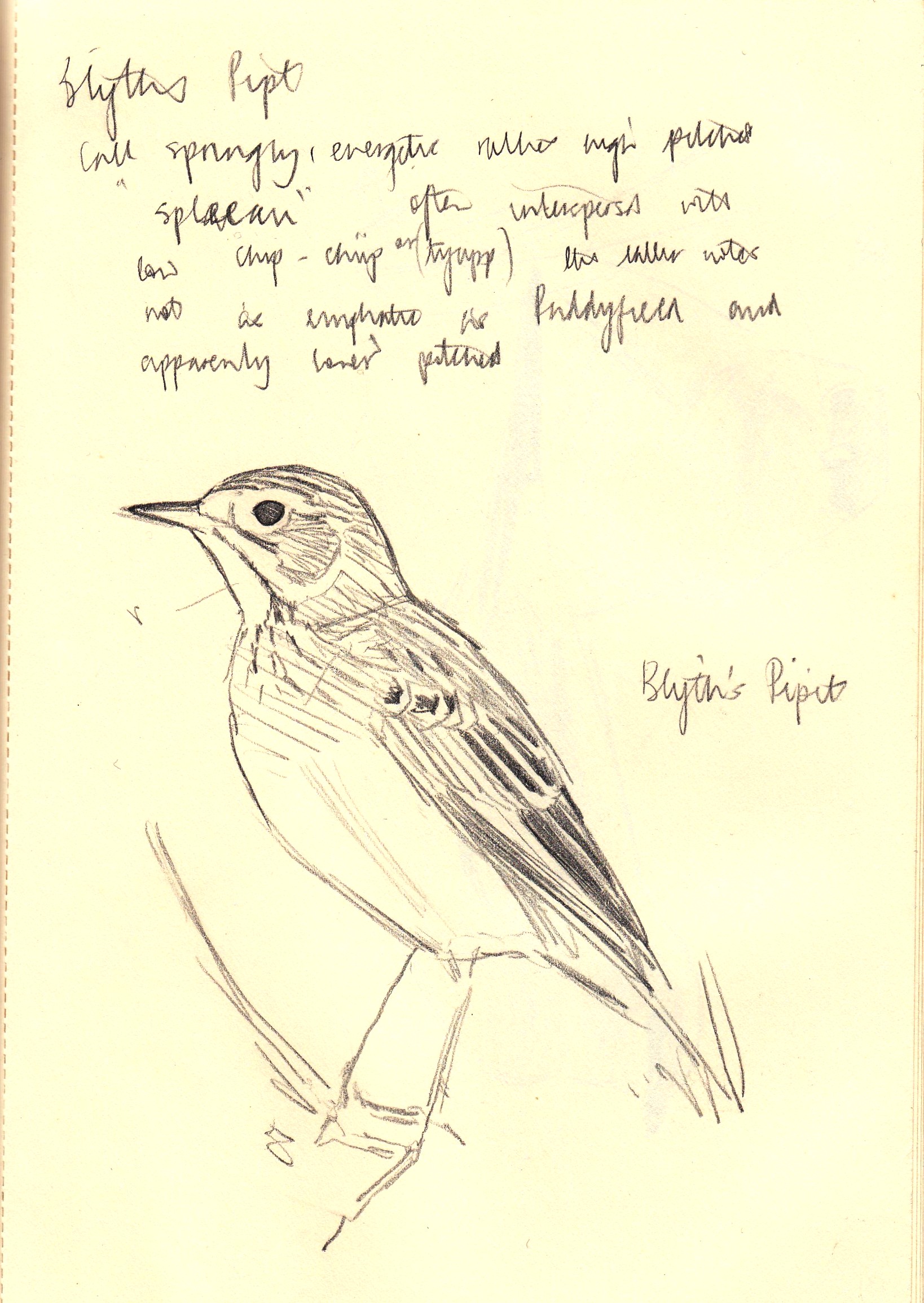
Blyth’s Pipit Anthus godlewskii Goa, India, November 1997. In Goa, Richard’s Pipit A richardi, Blyth’s Pipit and Paddyfield Pipit A rufulus all occur together, and it is an excellent place to become familiar with all three. While the majority conform in appearance to their respective species, variation produces the odd bird – for example a Richard’s with an unusually short bill – that can be challenging to identify. The distinctly different calls offer a very important clue to the identification of difficult birds, as indeed they do in the case of the Sennen pipit (Killian Mullarney)
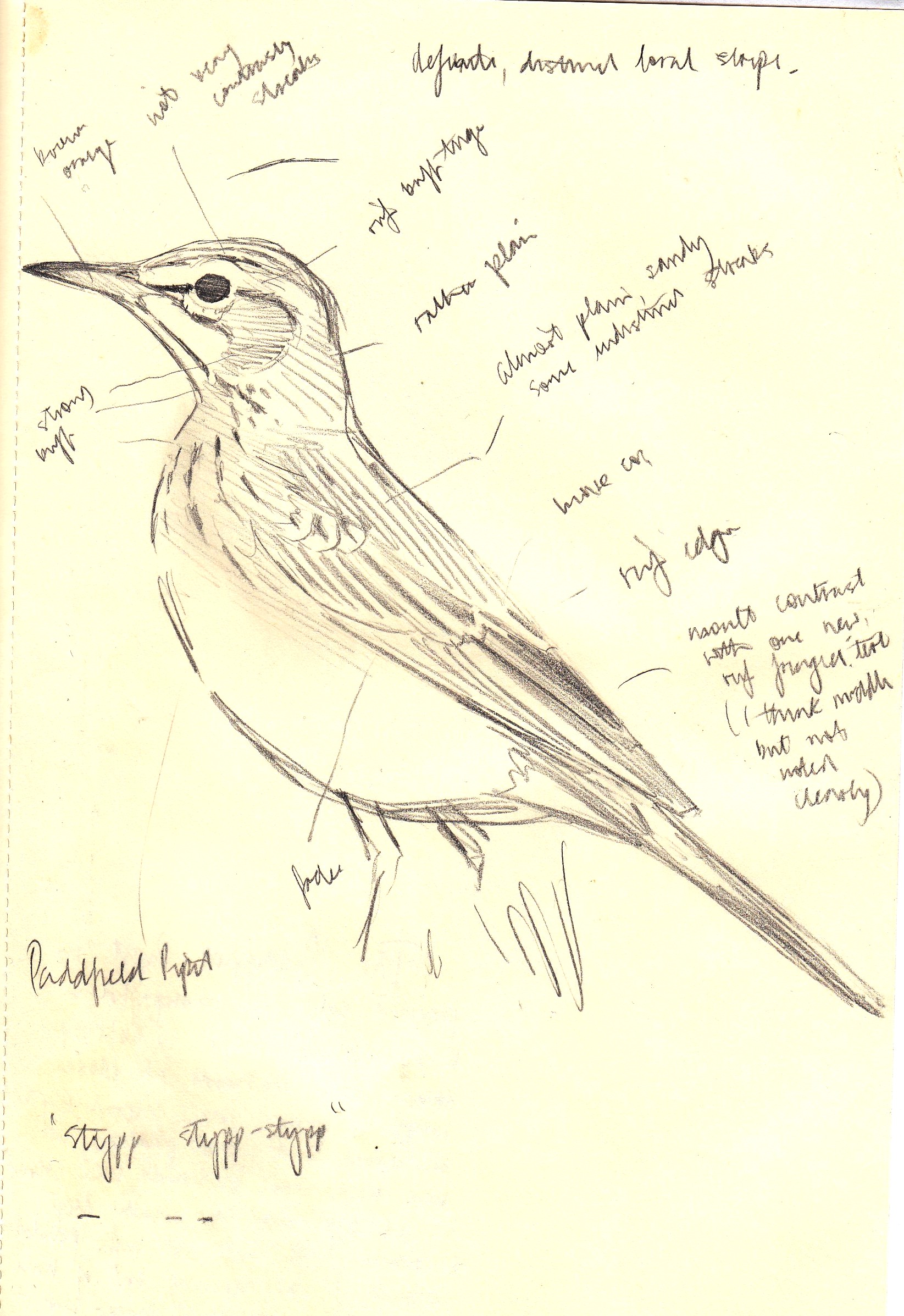
Paddyfield Pipit Anthus rufulus Goa, India, November 1997. Sketch with description of calls (Killian Mullarney)
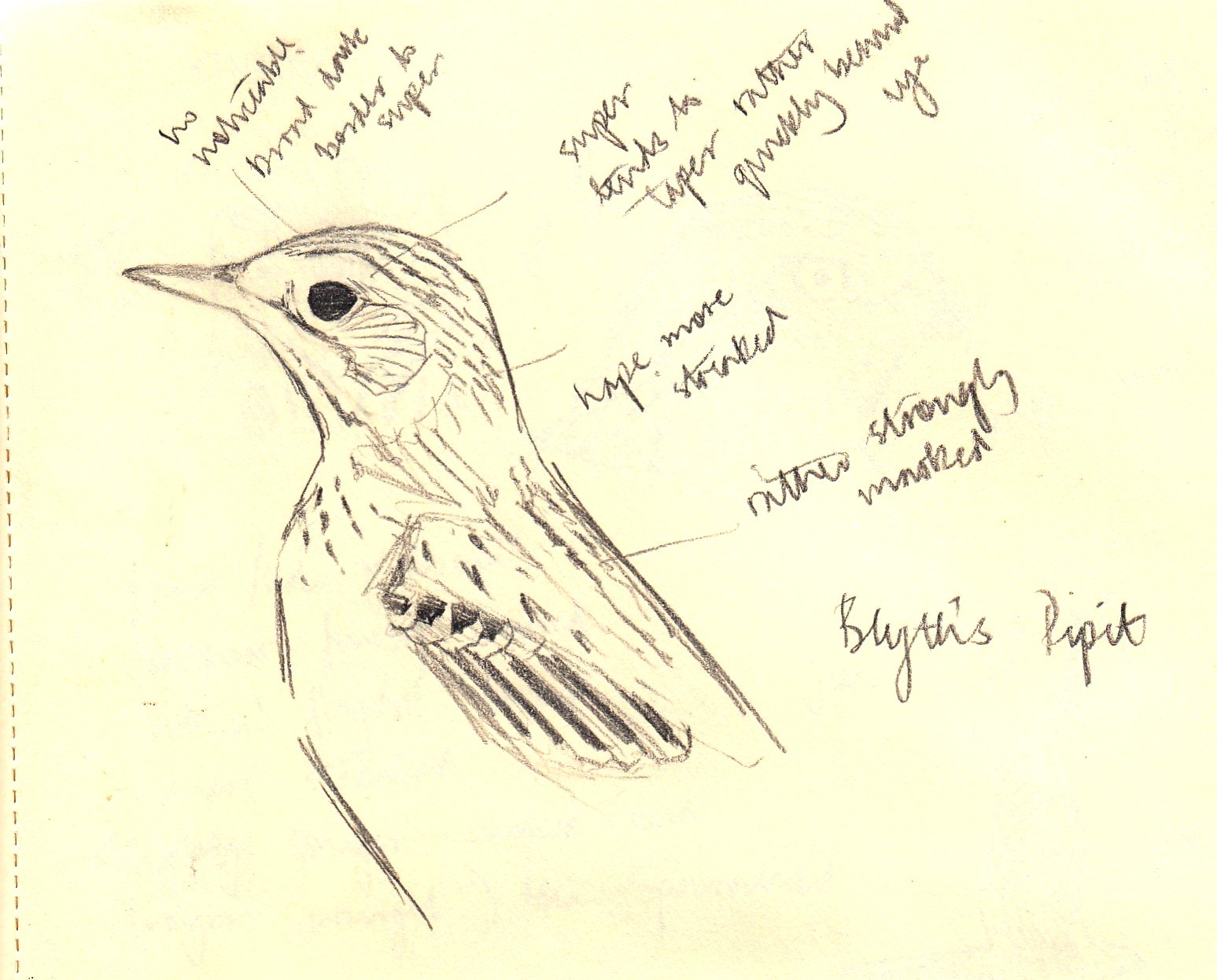
Blyth’s Pipit Anthus godlewskii Goa, India, November 1997. “Call, springy, energetic rather high-pitched spleeuu often interspersed with low chip or chüp (tyüpp) but latter notes not as emphatic as Paddyfield and apparently lower-pitched” (Killian Mullarney)
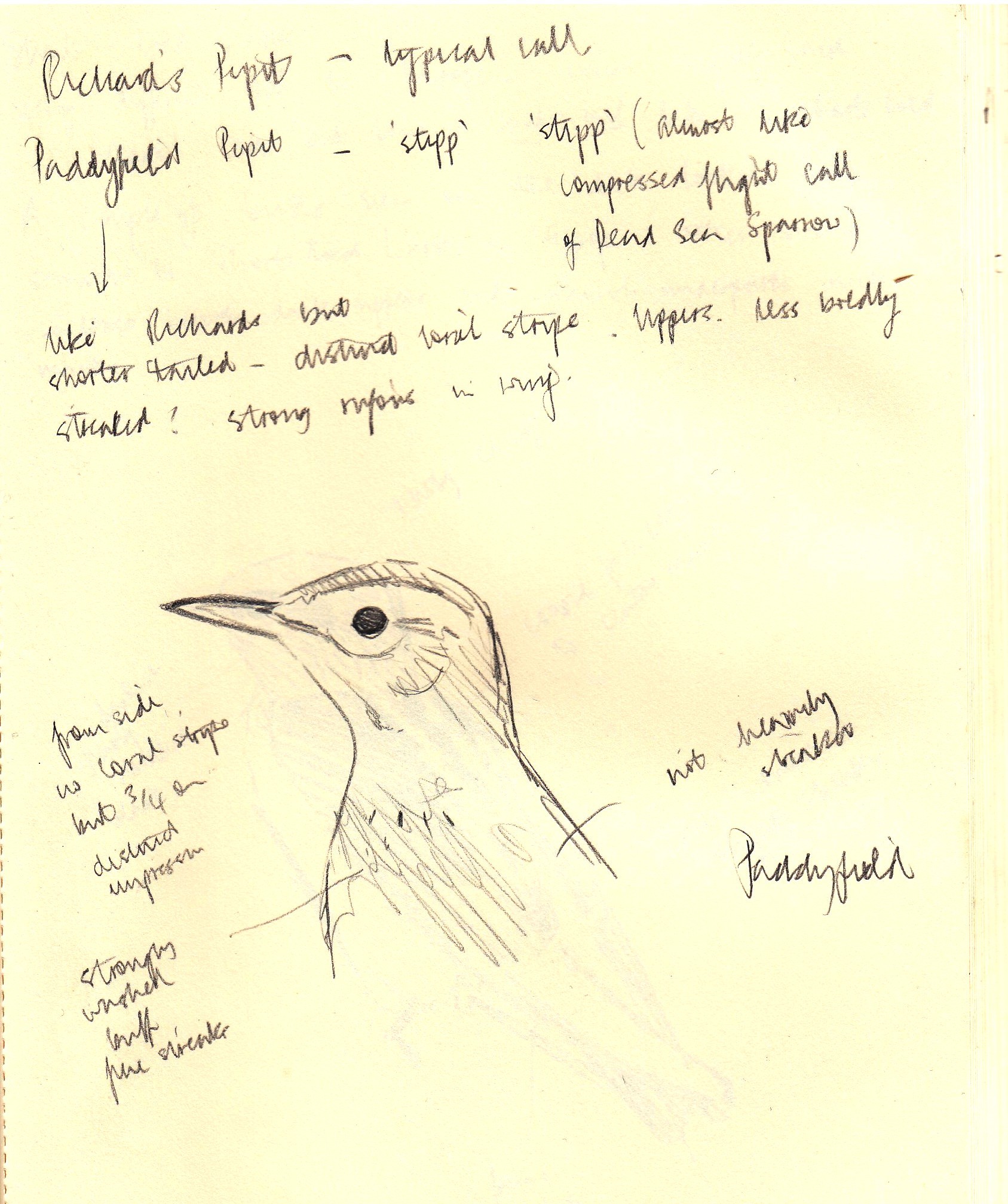
Paddyfield Pipit Anthus rufulus Goa, India, November 1997. “Stypp……… stypp-stypp or stipp almost like compressed flight-call of Dead Sea Sparrow” (Killian Mullarney)
Paddyfield and African Pipits
As I made clear above, Paddyfield Pipit and African Pipit have calls that are much closer to the Sennen pipit. Calls of Paddyfield are slightly more abrupt than those of African (ie, slightly shorter duration), showing a narrower frequency range with lower maximum and higher minimum frequency than African. But the most useful difference is one of shape. Neither species shows a ‘tentpole’ like Blyth’s Pipit; instead, the central structure of the call rises in a gradually narrowing arch to a high maximum frequency. The arch is flared at the base, and there are extremely fine modulations at the end of the call showing on all but the highest-resolution sonagrams as small fuzzy patches in the lower right edges.
As in all larger pipits, there are at least two prominent layers to the call. The lower one is the fundamental or first harmonic and the upper one is the second harmonic. The second harmonic follows the same contour as the fundamental at exactly twice the frequency. In Paddyfield the upper part of the fundamental has a more peaked form, and the second harmonic descends at some distance from it. African has a more arched form; the upper part of the fundamental is wider and the second harmonic hugs it more closely on the right side. This shape is not just something I saw in the first sonagrams I made for my convenience, and the measurements explained below should illustrate that it is a clear and consistent pattern.

Sonagram showing measurements B and C, the span of the fundamental at 6 kHz (B) and the distance to the second harmonic (C). Sennen pipit Anthus (left) Sennen, Cornwall, England, 24 October 2019 (Mashuq Ahmad); Paddyfield Pipit Anthus rufulus (middle) Divar island, Goa, India, 16 January 2013 (Arnoud B van den Berg) 130116.AB.122609.02; African Pipit Anthus cinnamomeus Belfontijn game reserve, Free State, South Africa, 17 January 2013 (Sander Bot) XC126558
So here is the nitty-gritty. The difference can best be illustrated by two measurements taken at 6 kHz. Measurement B is the mean span of the fundamental from the upslope to the downslope. Measurement C is the gap from the downslope of the fundamental to the downslope of the second harmonic. In Paddyfield the mean for B was 13 mS (range 7-18 ms, n = 11) and for C it was was 17 ms, ie, considerably longer than B. In African the mean for B was 23 ms (range 16–31 ms, n = 11) and for C it was 14 ms, or considerably shorter than measurement B. Were there exceptions? In Paddyfield one of the 11 individuals had B and C equal, but none had C shorter than B. In African, C was always shorter than B. Note that in Blyth’s Pipit and Richard’s Pipit these measurements are not possible as the fundamental does not reach 6 kHz.
Call measurements support Paddyfield Pipit
Most measurements of the Sennen pipit favoured Paddyfield rather than African, while one (maximum frequency) was closer to the mean for African but still within the range of Paddyfield. The measurements for structure were decisive. In the three clearest calls recorded by Mashuq Ahmad, the mean for B was 12 ms (below the lowest value for African) and the mean for C was 17 ms. C longer than B clearly indicates Paddyfield Pipit, not African Pipit.
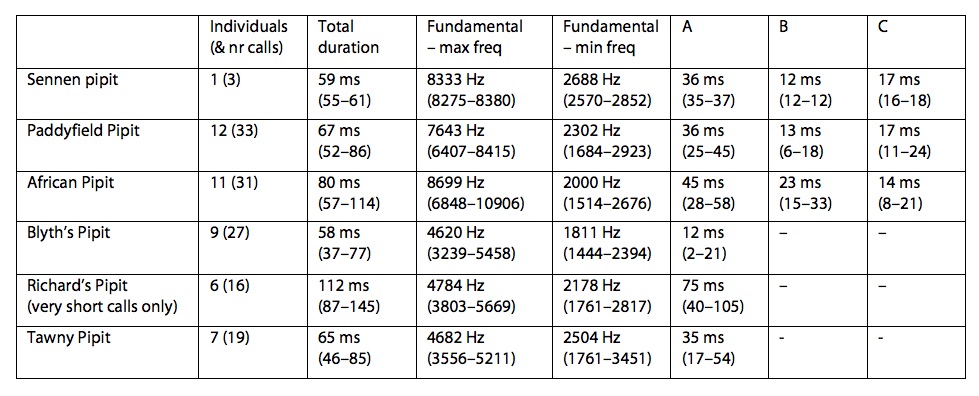
Table showing measurements for all four large pipit Anthus species analysed. Note that for Blyth’s Pipit A godlewskii I only measured chip–type flight calls (from nine individuals), and for Richard’s Pipit A richardi I measured only three calls each from the six individuals with the shortest calls I could find. So these measurements are not representative of normal Richard’s calls. The Tawny Pipits A campestris were four individuals from Portugal and one each from Bulgaria, Cyprus and Oman. Of the Paddyfield Pipit A rufulus calls, nine were from India, two from Vietnam, and one a vagrant in the United Arab Emirates. The African Pipit A cinnamomeus calls were from South Africa (five), Ethiopia (three), Malawi (two) and Tanzania (one).
Final comments
My purpose here has been to show why the calls of the Sennen bird strongly indicate Paddyfield Pipit. How a Paddyfield, never recorded anywhere west of the Arabian peninsula, came to be in Cornwall is not something that can be solved through analysis of vocalisations.
Although nothing clearly indicates this at present, the possibility exists that the bird may in fact be a hybrid with only one of its parents being a Paddyfield Pipit. I gather that DNA has been collected, in the form of faeces, and sent to Aberdeen University for analysis. Of course, it will be simpler for everyone if this gives us the same conclusion: Paddyfield Pipit. However, if the mtDNA comes back as another species the bird may still be half Paddyfield. MtDNA is inherited only from the mother, which could in this case be a species that is a long distance migrant. However, it may still have inherited its calls from a Paddyfield Pipit father. Only analysis of nuclear DNA would allow us to discount this possibility completely.
Acknowledgements
I would like to acknowledge Paul St Pierre the original finder of the large pipit in Sennen, Mashuq Ahmad and Nick Moran for letting me use their recordings and Mashuq his photographs, and James Lidster for alerting me to the bird in the first place. Toby Phelps made the recording that first awakened my suspicions. Thanks to Sander Bot for allowing me to include his African Pipit recording here. I would also like to acknowledge the team behind Xeno-canto and the following contributors: Patrik Åberg, Peter Boesman, Sander Bot, Oscar Campbell, Yuri Glushchenko, Louis Hansen, Albert Lastukhin, Arnold Meijer and Stein Nielsen. It was their recordings that I used, along with our own, in the analysis. Finally, thanks to Michiel van den Bergh, Stephen Menzie, Roy Slaterus and several others already mentioned for commenting on the text before it went online.
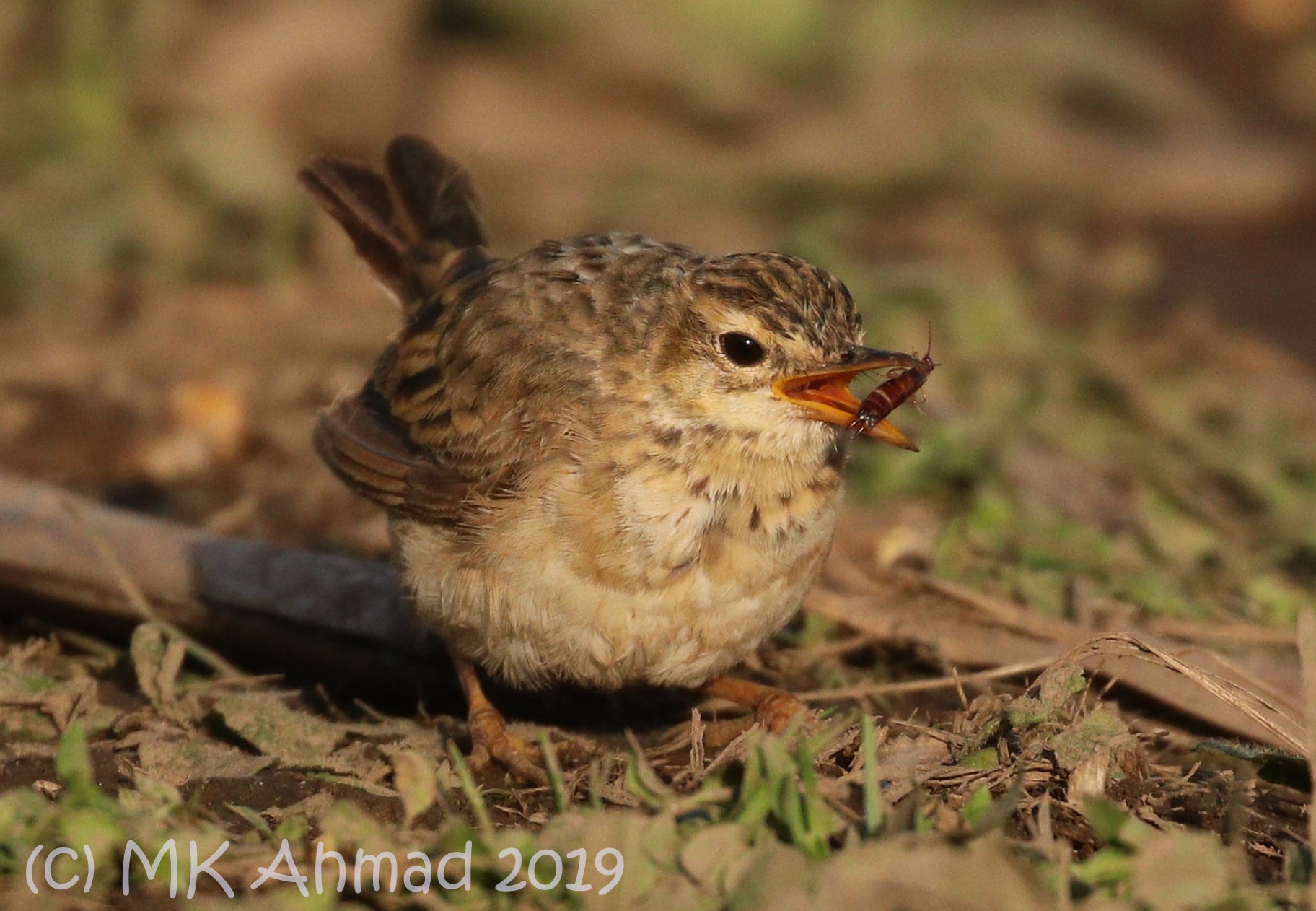
Paddyfield Pipit Anthus rufulus with probable Lesne’s Earwig Forficula lesnei Sennen, Cornwall, England, 3 November 2019 (Mashuq Ahmad)
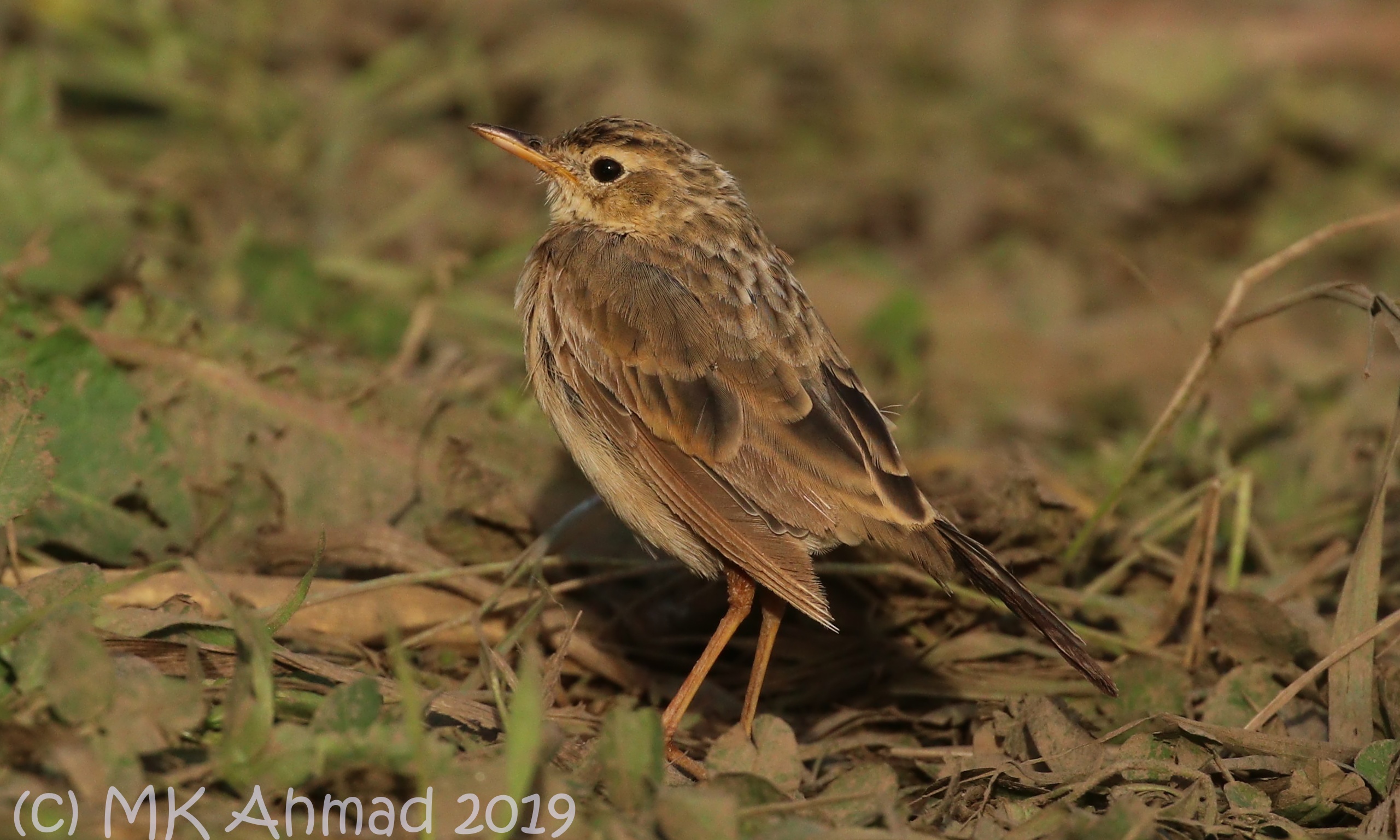
Paddyfield Pipit Anthus rufulus Sennen, Cornwall, England, 3 November 2019 (Mashuq Ahmad)